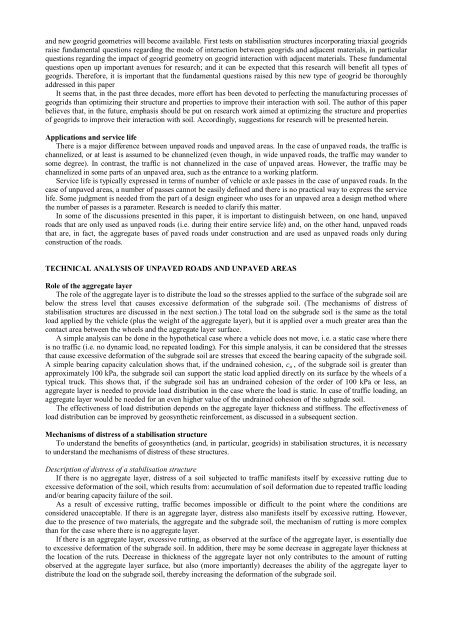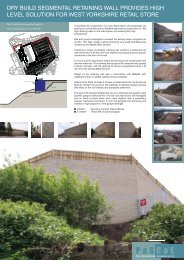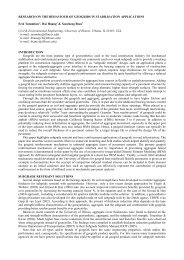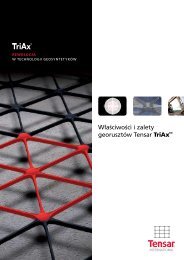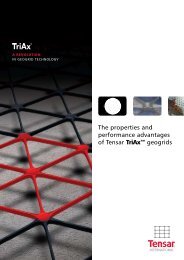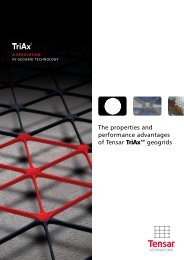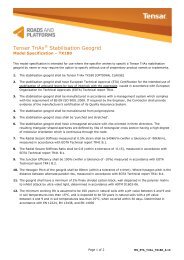3_JP Giroud_edited - Tensar International Ltd.
3_JP Giroud_edited - Tensar International Ltd.
3_JP Giroud_edited - Tensar International Ltd.
You also want an ePaper? Increase the reach of your titles
YUMPU automatically turns print PDFs into web optimized ePapers that Google loves.
and new geogrid geometries will become available. First tests on stabilisation structures incorporating triaxial geogrids<br />
raise fundamental questions regarding the mode of interaction between geogrids and adjacent materials, in particular<br />
questions regarding the impact of geogrid geometry on geogrid interaction with adjacent materials. These fundamental<br />
questions open up important avenues for research; and it can be expected that this research will benefit all types of<br />
geogrids. Therefore, it is important that the fundamental questions raised by this new type of geogrid be thoroughly<br />
addressed in this paper<br />
It seems that, in the past three decades, more effort has been devoted to perfecting the manufacturing processes of<br />
geogrids than optimizing their structure and properties to improve their interaction with soil. The author of this paper<br />
believes that, in the future, emphasis should be put on research work aimed at optimizing the structure and properties<br />
of geogrids to improve their interaction with soil. Accordingly, suggestions for research will be presented herein.<br />
Applications and service life<br />
There is a major difference between unpaved roads and unpaved areas. In the case of unpaved roads, the traffic is<br />
channelized, or at least is assumed to be channelized (even though, in wide unpaved roads, the traffic may wander to<br />
some degree). In contrast, the traffic is not channelized in the case of unpaved areas. However, the traffic may be<br />
channelized in some parts of an unpaved area, such as the entrance to a working platform.<br />
Service life is typically expressed in terms of number of vehicle or axle passes in the case of unpaved roads. In the<br />
case of unpaved areas, a number of passes cannot be easily defined and there is no practical way to express the service<br />
life. Some judgment is needed from the part of a design engineer who uses for an unpaved area a design method where<br />
the number of passes is a parameter. Research is needed to clarify this matter.<br />
In some of the discussions presented in this paper, it is important to distinguish between, on one hand, unpaved<br />
roads that are only used as unpaved roads (i.e. during their entire service life) and, on the other hand, unpaved roads<br />
that are, in fact, the aggregate bases of paved roads under construction and are used as unpaved roads only during<br />
construction of the roads.<br />
TECHNICAL ANALYSIS OF UNPAVED ROADS AND UNPAVED AREAS<br />
Role of the aggregate layer<br />
The role of the aggregate layer is to distribute the load so the stresses applied to the surface of the subgrade soil are<br />
below the stress level that causes excessive deformation of the subgrade soil. (The mechanisms of distress of<br />
stabilisation structures are discussed in the next section.) The total load on the subgrade soil is the same as the total<br />
load applied by the vehicle (plus the weight of the aggregate layer), but it is applied over a much greater area than the<br />
contact area between the wheels and the aggregate layer surface.<br />
A simple analysis can be done in the hypothetical case where a vehicle does not move, i.e. a static case where there<br />
is no traffic (i.e. no dynamic load, no repeated loading). For this simple analysis, it can be considered that the stresses<br />
that cause excessive deformation of the subgrade soil are stresses that exceed the bearing capacity of the subgrade soil.<br />
A simple bearing capacity calculation shows that, if the undrained cohesion, c u , of the subgrade soil is greater than<br />
approximately 100 kPa, the subgrade soil can support the static load applied directly on its surface by the wheels of a<br />
typical truck. This shows that, if the subgrade soil has an undrained cohesion of the order of 100 kPa or less, an<br />
aggregate layer is needed to provide load distribution in the case where the load is static. In case of traffic loading, an<br />
aggregate layer would be needed for an even higher value of the undrained cohesion of the subgrade soil.<br />
The effectiveness of load distribution depends on the aggregate layer thickness and stiffness. The effectiveness of<br />
load distribution can be improved by geosynthetic reinforcement, as discussed in a subsequent section.<br />
Mechanisms of distress of a stabilisation structure<br />
To understand the benefits of geosynthetics (and, in particular, geogrids) in stabilisation structures, it is necessary<br />
to understand the mechanisms of distress of these structures.<br />
Description of distress of a stabilisation structure<br />
If there is no aggregate layer, distress of a soil subjected to traffic manifests itself by excessive rutting due to<br />
excessive deformation of the soil, which results from: accumulation of soil deformation due to repeated traffic loading<br />
and/or bearing capacity failure of the soil.<br />
As a result of excessive rutting, traffic becomes impossible or difficult to the point where the conditions are<br />
considered unacceptable. If there is an aggregate layer, distress also manifests itself by excessive rutting. However,<br />
due to the presence of two materials, the aggregate and the subgrade soil, the mechanism of rutting is more complex<br />
than for the case where there is no aggregate layer.<br />
If there is an aggregate layer, excessive rutting, as observed at the surface of the aggregate layer, is essentially due<br />
to excessive deformation of the subgrade soil. In addition, there may be some decrease in aggregate layer thickness at<br />
the location of the ruts. Decrease in thickness of the aggregate layer not only contributes to the amount of rutting<br />
observed at the aggregate layer surface, but also (more importantly) decreases the ability of the aggregate layer to<br />
distribute the load on the subgrade soil, thereby increasing the deformation of the subgrade soil.


